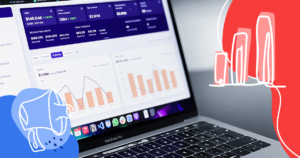If you want to bring as much traffic as possible to your website, you need to invest in search engine optimization (SEO). However, while most people understand that SEO refers to elements like keywords and meta tags, there’s another way to make your site rank higher on search results – content optimization.
Content marketing is a valuable part of any advertising strategy, with most marketers (67 percent) reporting that high-value content generates leads and traffic. Even better, this content can help breed loyalty among customers and visitors, so you have to work less to retain them.
With that in mind, let’s dive into the world of content optimization and see how you can make your marketing strategy work smarter.
What is Content Optimization?
Content optimization is the process of refining your marketing materials so they can rank higher on search results and drive traffic to your website.
The second stage of content optimization is converting new leads into customers with insightful information and compelling calls to action.
As you may imagine, these objectives are easier said than done. These days, it’s not enough to produce content – you have to make it exciting, engaging, and valuable.
Making the process even more complicated is that you must toe the line between appealing to search engines and users.
Fortunately, you can use different methods and tricks to ensure that every piece you produce is as optimized as possible. That said, you must be willing to dive deeper than just coming up with keywords and running through a checklist of SEO-related tasks.
Why is Content Optimization Important for SEO?
The primary goal of SEO marketing is to help your site rank as high as possible on search engine results pages (SERPs).
Google ranks pages based on tons of unique variables, but the overarching component is “relevance.” If someone enters a search query, they want to find landing pages, articles, and videos related to their search, not just random content that may or may not apply.
So, content optimization is vital for SEO because it ensures that your marketing materials reach the widest audience possible.
If your content doesn’t rank on the first page, it may as well not exist (at least, as far as search engines are concerned). Optimization ensures your materials are as relevant and engaging as possible so they rank higher, especially when compared to competing content.
How Do I Optimize Content for SEO?
Although Google’s algorithm is notoriously secret, it’s not hard to discover which elements will help content rank higher. Here are some tried-and-true methods to ensure each piece you produce has the best chance of finding and building an audience.
Start With Keyword and Topic Research
Keyword research is a fundamental aspect of SEO, so you should spend a good amount of time on it.
However, there are multiple layers to this process, so you have to be able to incorporate each component, including:
- Search Volume – Since your primary goal is to increase site traffic, you want to focus on keywords that have a significant search volume. However, remember that your competitors will also be trying to rank for these words, so you have to plan accordingly. Realistically, you want to focus on both moderate to high-volume keywords that can generate consistent traffic.
- Niche Keywords – Most people have a specific idea in mind when searching for something online. For example, if someone is looking for a lasagna recipe, they won’t search for a “delicious pasta recipe.” Instead, they’ll likely search for something like, “what’s an easy lasagna recipe for beginners?” As you can imagine, both queries will generate vastly different results. When producing content, you want to appeal to the second query since it’s easier to ensure it will be relevant to their needs. Even if a more generic term has higher traffic, it’s harder to understand user intent, so your content may or may not be valuable.
- Semantically-Related Keywords – While your primary keyword is valuable for content optimization, it’s not the only thing you should focus on when producing marketing materials. Semantically-related keywords help you understand user intent better by diving deeper into the first query. Basically, these keywords help you understand why someone is searching online so that you can produce more valuable and relevant content.
Once you’ve conducted keyword research, you should be able to group them into topics. From there, you can develop content ideas based on these topics.
Also, remember that you can likely produce multiple pieces of content for a single topic. For example, you can write a blog post, shoot a video, and create an infographic about the same keyword set.
Create a Relevant and Keyword-Specific Outline
Keyword groups aren’t just valuable for determining the type of content you should produce. They can also help you outline your content by using them as headers, sub-headers, and bullet points. Building this structure not only ensures you can maintain relevance throughout the content but that you can also stay focused and not veer off-topic.
Outlines are not just valuable for blog posts, either. You can create structures for landing pages, videos, infographics, and more.
Consider Your Keyword Density
In the early days of search engine optimization, marketers learned they could “hack” their way to a higher rank by stuffing tons of keywords into a piece. Fortunately, Google quickly caught on and started penalizing sites that followed this practice.
Today, keyword density is much more nuanced, so you have to be careful to do it correctly. If you add too many keywords to a piece, you could get dinged and wind up with a lower rank.
However, if you use too few of them, your content may not seem relevant enough, meaning that search engines won’t rank it high enough.
Also, don’t forget that you’re writing for people, not bots. So, you should ensure your keywords don’t sound too clunky or artificial – they should flow naturally within the content and make sense in context. Otherwise, they could lead to a negative user experience.
Integrate Visual Elements
Humans are naturally visual creatures, meaning we tend to gravitate toward content that uses pictures, graphics, or video elements.
While you can break up walls of text with headers, bullet points, and shorter paragraphs, you should also utilize images whenever possible.
The added benefit of incorporating visual elements is that they can boost your optimization strategy. Image alt tags and captions help bots index the page correctly, all without affecting the readability or context of the content itself.
Also, if you’re producing proprietary visuals, you can use them as promotional materials when publishing a new piece.
Link Strategically
Hyperlinks are essential to SEO because they make it easier for search engines to index pages. When producing new content, you need to incorporate a mix of internal and external links so that Google will rank it higher.
However, there is more to this process than just adding hyperlinks here and there. Follow these tips as well:
- Use Anchor Text – Let’s say you’re linking to a page about marketing statistics. Instead of putting the hyperlink on a random word, it should either be on one of the statistics or a phrase related to them. Anchor text provides crucial context for a link, so web crawlers know why you’re linking to it.
- Use Valuable Links – When providing internal links, don’t just send visitors to a random page. Instead, you should link to relevant pages within your site. These pages can include contact information, other content pieces, or product listings. The same goes for external links too. Consider why someone might click the link and what they expect to see after clicking. If the landing page doesn’t match their expectations, it can be jarring for the user.
- Link to High-Quality Sites – Google prefers content that has a robust and reliable link network. So, if you’re linking to low-traffic sites or unsecured pages, Google will ding your ranking accordingly. As a rule, it’s best to link to other sites with a high authority rating. There are free tools available (like the Domain Authority Checker from Moz).
Bottom Line: Be Relevant to Your Target Audience!
Overall, no matter what methods or tactics you use for content optimization, each action should focus on one goal – user relevance.
Since this is the primary objective of Google’s algorithm, you must take the same approach when producing new content for your site.
Here are some general rules to follow include:
- Stay Focused – Don’t try to tackle too many topics in a single piece. Instead, it’s better to break them into separate pieces if possible.
- Front-Load Crucial Information – Users don’t want to scroll through the text to find what they need. Provide the most relevant information upfront and then dive into further detail afterward. This way, users can get what they want immediately and then have the choice of digging deeper into the topic.
- Use Headers to Your Advantage – Most people will skim an article to decide if they want to read it. If your headings and sub-headings are too generic or don’t seem relevant, your audience will leave immediately. Also, incorporating keywords into headers helps bots index the page correctly.
Content Optimization SEO Strategies
Now that you know how to optimize your content for SEO, let’s discuss a few ways to develop more content for your site. Overall, the goal is to build momentum, so your site traffic stays consistent over the long term. Knowing how to generate relevant and optimized content is crucial so you don’t fall behind.
Create Topic Clusters Based on Keywords
Once you’ve conducted comprehensive keyword research, you should be able to create topic clusters around them. From there, you can decide what types of content to produce and build a schedule around it.
When developing these topic clusters, you should also consider the type of content you want to produce.
While blog posts will be the most common, don’t forget about infographics, videos, white papers, e-books, and more.
In fact, you could create multiple types of content for the same topic cluster and focus on different aspects of the subject in each piece.
Research Traffic and Rank Your Keywords
Keyword traffic fluctuates all the time, so you have to check in regularly to ensure you’re focused on the topics and keywords that get the most hits.
Ideally, after creating topic clusters, you can rank them by search volume so you can put your energy into content that will generate the most leads as quickly as possible.
From there, you should re-rank your remaining topic clusters based on emerging trends and changes in search volume. Also, remember that some topics may be on a downward trend, meaning they won’t be relevant in the future.
Instead, it’s better to focus on upward trends or issues that are always relevant to your audience (i.e., evergreen).
Don’t Forget About Meta Titles and Meta Descriptions
While your primary goal is to produce high-quality and relevant content, you can’t skimp on the details.
Meta titles, title tags, meta descriptions, alt text, and captions are all part of a greater SEO strategy. When creating a new piece, you should have a system to check and double-check each of these elements, so nothing is missing.
For example, when sourcing (or producing) images for a blog post, you have to pay attention to the following:
- Image Name – If the filename is something like IMG_87692, that doesn’t mean anything to a search engine. Instead, rename it to something relevant to the content (ideally a keyword, if possible).
- Alt Text – This text shows up if the image can’t load on the page. It’s also used for screen readers for those with impaired vision, so it’s essential.
- Caption – Captions aren’t always necessary unless the image provides extra context for the piece. You can also utilize keywords here as long as they fit in naturally.
- Image Size – High-resolution photos look good but slow down your page speed. Make sure to reformat the image so it loads as quickly as possible.
As you can see, there are tons of small elements that are easy to overlook.
If possible, create a checklist of these components to double-check each new piece before it gets published.
Use Multiple Types of Media
As a rule, video content is the most engaging, followed by visual content (i.e., an infographic), and then text-based pieces like blog posts and white papers.
Overall, your content optimization strategy should incorporate a diverse selection of different mediums so you can appeal to a broader audience.
Also, it’s easier to share and promote your content across different platforms and social media channels.
Here’s a quick list of the different types of digital content you can produce:
- Blog Posts
- Product Listings
- Testimonials
- White Papers
- E-Books
- Webinars
- Photos and Illustrations
- Infographics
- Videos
- Live Streams
- Tutorials
Overall, let your creativity run wild and never feel limited or constrained to one type of content.
Use Automation to Set a Content Release Schedule
Creating, publishing, and promoting new content is a full-time job, so it’s hard for businesses and websites to maintain long-term momentum. Fortunately, automated tools make it easier to share new pieces across different platforms.
With these tools, your marketing team can focus more on content development and production since they don’t have to worry about posting on specific sites at different times.
That said, user engagement is a huge part of content optimization, as the more traffic surrounding a piece will make it rank higher. So, don’t forget to engage with your audience on social media and other channels (i.e., YouTube). Not only can you rally your audience behind a piece, but you can gather valuable insight into what your audience wants and expects.
User feedback is crucial because it ensures you’re always focused on meaningful content that will maintain or increase your site traffic. Basically, don’t just “set it and forget it” when posting new pieces.
Get Better SEO Content With Rock Content
Even if you follow these steps, it’s hard to create captivating content from scratch. Fortunately, Writer Access by Rock Content allows you to tap into a vast pool of writers and creators that can help bring your vision to life. Get a free trial of Writer Access and discover what kind of high-quality material you can get.


![[ROCK NA] [EBOOK SEO] Complete Guide](https://rockcontent.com/wp-content/uploads/2024/06/banner_Search-Engine-Optimization.png)






